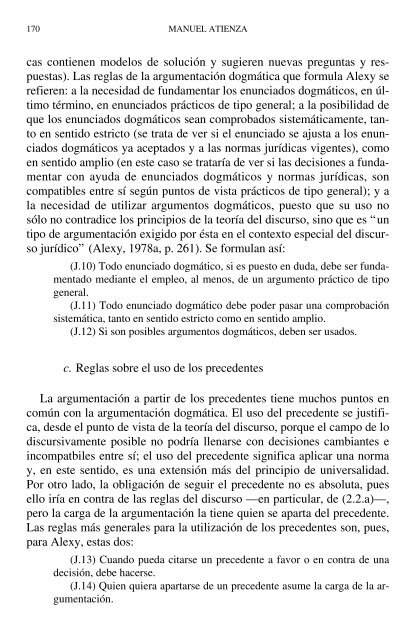LAS RAZONES DEL DERECHO Teo rías de la ar gu men ta ción ju rí di ca
You also want an ePaper? Increase the reach of your titles
YUMPU automatically turns print PDFs into web optimized ePapers that Google loves.
170 MANUEL ATIENZA<br />
<strong>ca</strong>s contienen mo<strong>de</strong>los <strong>de</strong> solu<strong>ción</strong> y sugieren nuevas pre<strong>gu</strong>n<strong>ta</strong>s y respues<strong>ta</strong>s).<br />
Las reg<strong>la</strong>s <strong>de</strong> <strong>la</strong> <strong>ar</strong><strong>gu</strong><strong>men</strong><strong>ta</strong><strong>ción</strong> dogmáti<strong>ca</strong> que formu<strong>la</strong> Alexy se<br />
refieren: a <strong>la</strong> necesidad <strong>de</strong> funda<strong>men</strong>t<strong>ar</strong> los enunciados dogmáticos, en último<br />
término, en enunciados prácticos <strong>de</strong> tipo general; a <strong>la</strong> posibilidad <strong>de</strong><br />
que los enunciados dogmáticos sean comprobados sistemáti<strong>ca</strong><strong>men</strong>te, <strong>ta</strong>nto<br />
en sentido estricto (se tra<strong>ta</strong> <strong>de</strong> ver si el enunciado se a<strong>ju</strong>s<strong>ta</strong> a los enunciados<br />
dogmáticos ya acep<strong>ta</strong>dos y a <strong>la</strong>s normas <strong>ju</strong><strong>rí</strong><strong>di</strong><strong>ca</strong>s vigentes), como<br />
en sentido amplio (en este <strong>ca</strong>so se trat<strong>ar</strong>ía <strong>de</strong> ver si <strong>la</strong>s <strong>de</strong>cisiones a funda<strong>men</strong>t<strong>ar</strong><br />
con ayuda <strong>de</strong> enunciados dogmáticos y normas <strong>ju</strong><strong>rí</strong><strong>di</strong><strong>ca</strong>s, son<br />
compatibles entre sí según puntos <strong>de</strong> vis<strong>ta</strong> prácticos <strong>de</strong> tipo general); y a<br />
<strong>la</strong> necesidad <strong>de</strong> utiliz<strong>ar</strong> <strong>ar</strong><strong>gu</strong><strong>men</strong>tos dogmáticos, puesto que su uso no<br />
sólo no contra<strong>di</strong>ce los principios <strong>de</strong> <strong>la</strong> teo<strong>rí</strong>a <strong>de</strong>l <strong>di</strong>scurso, sino que es “un<br />
tipo <strong>de</strong> <strong>ar</strong><strong>gu</strong><strong>men</strong><strong>ta</strong><strong>ción</strong> exigido por és<strong>ta</strong> en el contexto especial <strong>de</strong>l <strong>di</strong>scurso<br />
<strong>ju</strong><strong>rí</strong><strong>di</strong>co” (Alexy, 1978a, p. 261). Se formu<strong>la</strong>n así:<br />
(J.10) Todo enunciado dogmático, si es puesto en duda, <strong>de</strong>be ser funda<strong>men</strong><strong>ta</strong>do<br />
me<strong>di</strong>ante el empleo, al <strong>men</strong>os, <strong>de</strong> un <strong>ar</strong><strong>gu</strong><strong>men</strong>to práctico <strong>de</strong> tipo<br />
general.<br />
(J.11) Todo enunciado dogmático <strong>de</strong>be po<strong>de</strong>r pas<strong>ar</strong> una comproba<strong>ción</strong><br />
sistemáti<strong>ca</strong>, <strong>ta</strong>nto en sentido estricto como en sentido amplio.<br />
(J.12) Si son posibles <strong>ar</strong><strong>gu</strong><strong>men</strong>tos dogmáticos, <strong>de</strong>ben ser usados.<br />
c. Reg<strong>la</strong>s sobre el uso <strong>de</strong> los prece<strong>de</strong>ntes<br />
La <strong>ar</strong><strong>gu</strong><strong>men</strong><strong>ta</strong><strong>ción</strong> a p<strong>ar</strong>tir <strong>de</strong> los prece<strong>de</strong>ntes tiene muchos puntos en<br />
común con <strong>la</strong> <strong>ar</strong><strong>gu</strong><strong>men</strong><strong>ta</strong><strong>ción</strong> dogmáti<strong>ca</strong>. El uso <strong>de</strong>l prece<strong>de</strong>nte se <strong>ju</strong>stifi<strong>ca</strong>,<br />
<strong>de</strong>s<strong>de</strong> el punto <strong>de</strong> vis<strong>ta</strong> <strong>de</strong> <strong>la</strong> teo<strong>rí</strong>a <strong>de</strong>l <strong>di</strong>scurso, porque el <strong>ca</strong>mpo <strong>de</strong> lo<br />
<strong>di</strong>scursiva<strong>men</strong>te posible no pod<strong>rí</strong>a llen<strong>ar</strong>se con <strong>de</strong>cisiones <strong>ca</strong>mbiantes e<br />
incompatbiles entre sí; el uso <strong>de</strong>l prece<strong>de</strong>nte signifi<strong>ca</strong> aplic<strong>ar</strong> una norma<br />
y, en este sentido, es una extensión más <strong>de</strong>l principio <strong>de</strong> universalidad.<br />
Por otro <strong>la</strong>do, <strong>la</strong> obliga<strong>ción</strong> <strong>de</strong> se<strong>gu</strong>ir el prece<strong>de</strong>nte no es absolu<strong>ta</strong>, pues<br />
ello i<strong>rí</strong>a en contra <strong>de</strong> <strong>la</strong>s reg<strong>la</strong>s <strong>de</strong>l <strong>di</strong>scurso —en p<strong>ar</strong>ticu<strong>la</strong>r, <strong>de</strong> (2.2.a)—,<br />
pero <strong>la</strong> c<strong>ar</strong>ga <strong>de</strong> <strong>la</strong> <strong>ar</strong><strong>gu</strong><strong>men</strong><strong>ta</strong><strong>ción</strong> <strong>la</strong> tiene quien se ap<strong>ar</strong><strong>ta</strong> <strong>de</strong>l prece<strong>de</strong>nte.<br />
Las reg<strong>la</strong>s más generales p<strong>ar</strong>a <strong>la</strong> utiliza<strong>ción</strong> <strong>de</strong> los prece<strong>de</strong>ntes son, pues,<br />
p<strong>ar</strong>a Alexy, es<strong>ta</strong>s dos:<br />
(J.13) Cuando pueda cit<strong>ar</strong>se un prece<strong>de</strong>nte a favor o en contra <strong>de</strong> una<br />
<strong>de</strong>cisión, <strong>de</strong>be hacerse.<br />
(J.14) Quien quiera ap<strong>ar</strong>t<strong>ar</strong>se <strong>de</strong> un prece<strong>de</strong>nte asume <strong>la</strong> c<strong>ar</strong>ga <strong>de</strong> <strong>la</strong> <strong>ar</strong><strong>gu</strong><strong>men</strong><strong>ta</strong><strong>ción</strong>.



